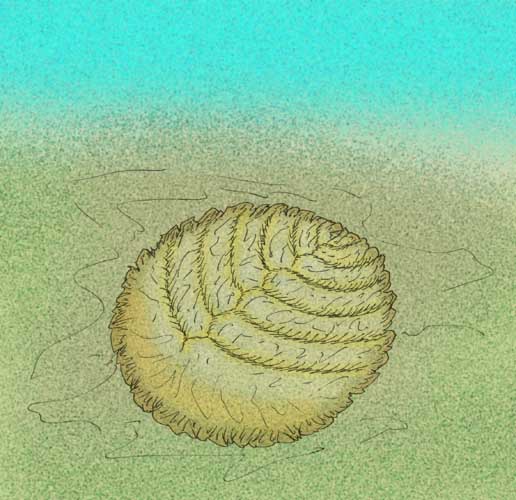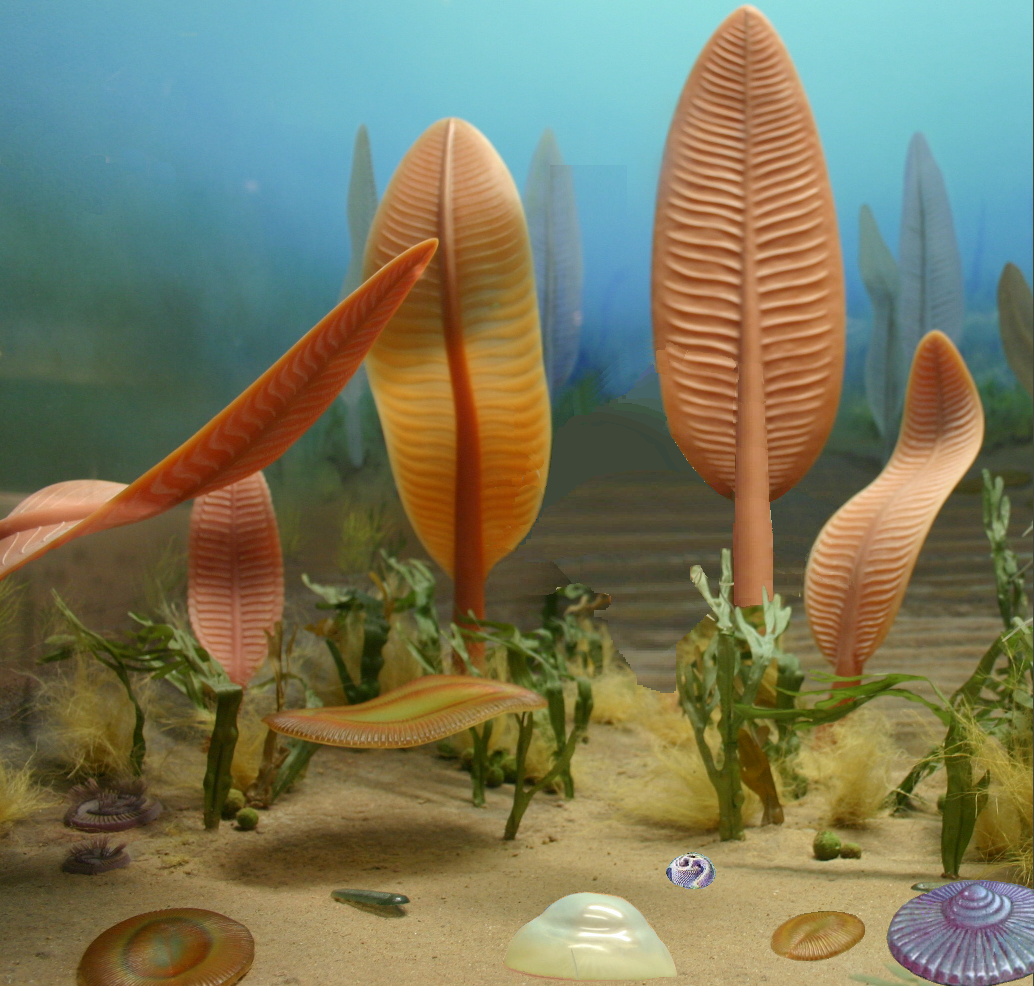|
Karakhtia Nessovi
''Karakhtia nessovi'' is a species of Proarticulate from the Ediacaran period, around 555 Million Years Ago. K. nessovi is the only species in the genus ''Karakhtia''. The genus ''Haootia'' has been compared minorly to ''Karakhtia'' in the way that the fossils of ''Haootia'' superficially resemble the crumpled margins of ''Karakhtia''. Discovery and name The holotype fossil of ''Karakhtia'' was found from the Ustʹ Pinega Formation, in the White Sea of Russia, and described in 2004. The generic name ''Karakhtia'' is derived from the place name ''Karakhta River'', near to where the fossil material was found. The specific name ''nessovi'' is derived from the surname of ''L.A. Nessov'', a Leningrad paleontologist. Description ''Karakhtia nessovi'' is a Proarticulate from the Vendiidae family, growing up to in length, and like other members of its family, it has a headshield-like structure. Unlike anything seen in other Proarticulates, it features a margin with radial folds ... [...More Info...] [...Related Items...] OR: [Wikipedia] [Google] [Baidu] |
Ediacaran
The Ediacaran ( ) is a geological period of the Neoproterozoic geologic era, Era that spans 96 million years from the end of the Cryogenian Period at 635 Million years ago, Mya to the beginning of the Cambrian Period at 538.8 Mya. It is the last period of the Proterozoic geologic eon, Eon as well as the last of the so-called "Precambrian supereon", before the beginning of the subsequent Cambrian Period marks the start of the Phanerozoic Eon, where recognizable fossil evidence of life becomes common. The Ediacaran Period is named after the Ediacara Hills of South Australia, where trace fossils of a diverse community of previously unrecognized lifeforms (later named the Ediacaran biota) were first discovered by geologist Reg Sprigg in 1946. Its status as an official geological period was ratified in 2004 by the International Union of Geological Sciences (IUGS), making it the first new geological period declared in 120 years. Although the period took namesake from the Ediacara Hills ... [...More Info...] [...Related Items...] OR: [Wikipedia] [Google] [Baidu] |
Animalia
Animals are multicellular, eukaryotic organisms in the Biology, biological Kingdom (biology), kingdom Animalia (). With few exceptions, animals heterotroph, consume organic material, Cellular respiration#Aerobic respiration, breathe oxygen, have myocytes and are motility, able to move, can reproduce sexually, and grow from a hollow sphere of Cell (biology), cells, the blastula, during embryonic development. Animals form a clade, meaning that they arose from a single common ancestor. Over 1.5 million extant taxon, living animal species have been species description, described, of which around 1.05 million are insects, over 85,000 are molluscs, and around 65,000 are vertebrates. It has been estimated there are as many as 7.77 million animal species on Earth. Animal body lengths range from to . They have complex ecologies and biological interaction, interactions with each other and their environments, forming intricate food webs. The scientific study of animals is known as ... [...More Info...] [...Related Items...] OR: [Wikipedia] [Google] [Baidu] |
Proarticulata
Proarticulata is a proposed phylum of extinct, near-bilaterally symmetrical animals known from fossils found in the Ediacaran (Vendian) marine deposits, and dates to approximately . The name comes from the Greek () = "before" and Articulata, i.e. prior to animals with true segmentation such as annelids and arthropods. This phylum was established by Mikhail A. Fedonkin in 1985 for such animals as ''Dickinsonia'', '' Vendia'', '' Cephalonega'', '' Praecambridium'' and currently many other Proarticulata are described (see list). Due to their simplistic morphology, their affinities and mode of life are subject to debate. They are almost universally considered to be metazoans, and due to possessing a clear central axis have been suggested to be stem-bilaterians. In the traditional interpretation, the Proarticulatan body is divided into transverse articulation (division) into isomers as distinct from the transverse articulation segments in annelids and arthropods, as their individu ... [...More Info...] [...Related Items...] OR: [Wikipedia] [Google] [Baidu] |
Vendiamorpha
Vendiamorpha is a class of extinct animals within the Ediacaran phylum Proarticulata. The typical vendiamorph had an oval-shaped or round-shaped body divided completely into segmented isomers, that were arranged alternately in two rows with reference to the longitudinal axis of the body. Description The phenomenon of left-right alternating segments is called ''glide reflection symmetry'', and is a diagnostic feature of proarticulates. Transverse elements decrease in size from one end to the other and are inclined in the same direction. Typically, the first few, or largest initial isomers are fused together to form a headshield-like structure, leading some researchers to have originally considered them to be ancestral or related to arthropods, though, overwhelming evidence of them being proarticulates have since led researchers to discard this hypothetical relationship. Some vendiamorphs (e.g., ''Vendia'' and ''Paravendia'') supposedly demonstrate a digestive-distributive sy ... [...More Info...] [...Related Items...] OR: [Wikipedia] [Google] [Baidu] |
Haootia
''Haootia quadriformis'' is an extinct animal belonging to the Ediacaran biota. Estimated to be about 560 million years old, ''H. quadriformis'' is identified as a cnidarian polyp, and represents the earliest known evidence for muscle tissue in an animal. Discovered in 2008 from Newfoundland in eastern Canada, it was formally described in 2014. It is the first Ediacaran organism discovered to show fossils of muscle fibres. Structural examination of the muscles and morphology indicate that the animal is a cnidarian, though, which class ''H. quadriformis'' belongs to was undetermined until a 2024 study found it to be a staurozoan. Discovery and name The first fossil of ''Haootia'' was discovered from lower Fermeuse Formation of Back Cove, Bonavista Peninsula in Newfoundland. It was originally unearthed by Martin D. Brasier of the University of Oxford in 2008. However, the specimen was not allowed to be removed according to provincial law in Newfoundland, so that only a pl ... [...More Info...] [...Related Items...] OR: [Wikipedia] [Google] [Baidu] |
Holotype
A holotype (Latin: ''holotypus'') is a single physical example (or illustration) of an organism used when the species (or lower-ranked taxon) was formally described. It is either the single such physical example (or illustration) or one of several examples, but explicitly designated as the holotype. Under the International Code of Zoological Nomenclature (ICZN), a holotype is one of several kinds of name-bearing types. In the International Code of Nomenclature for algae, fungi, and plants (ICN) and ICZN, the definitions of types are similar in intent but not identical in terminology or underlying concept. For example, the holotype for the butterfly '' Plebejus idas longinus'' is a preserved specimen of that subspecies, held by the Museum of Comparative Zoology at Harvard University. In botany and mycology, an isotype is a duplicate of the holotype, generally pieces from the same individual plant or samples from the same genetic individual. A holotype is not necessarily "ty ... [...More Info...] [...Related Items...] OR: [Wikipedia] [Google] [Baidu] |
Ustʹ Pinega Formation
The Ust Pinega Formation is an Upper Ediacaran geological formation exposed along the banks of the Syuzma and Onega Rivers in Arkhangelsk Oblast, northwestern Russia, and spans from around 580 Ma to 550 Ma, with fossilferous stones restricted to between 565 and 555 Ma. It also preserves a wealth of rare Ediacaran fossils, like ''Zolotytsia'', ''Ventogyrus'' and ''Bomakellia''. Dating The Ustʹ Pinega Formation is relatively large, and using Uranium-lead dating, zircon U-Pb dating, a date of had been recovered for the top of the formtion, whilst the known base of the formation is restricted to . As for the lower and upper dates of the fossiliferous units within the formtaion, using the Rubidium–strontium dating, Rb–Sr dating method, the lowest fossiliferous unit of the Ustʹ Pinega Formation has been dated to , whilst the upper-most fossiliferous unit was dated using zircon U-Pb dating, which had recovered a date of . Paleobiota The Ustʹ Pinega Formation is home to man ... [...More Info...] [...Related Items...] OR: [Wikipedia] [Google] [Baidu] |
Vendia
''Vendia'' is an extinct vendiamorph from the late Ediacaran, estimated to be around 567 - 550 Ma years old, it contains two species, ''V. sokolovi'' and ''V. rachiata'', both of which are restricted to the Ust' Pinega Formation in Northwestern Russia. Discovery and naming The first fossil materials of ''Vendia'' were found in a core from a Yarensk borehole that was collected from the Ust' Pinega Formation of the Arkhangelsk Oblast, northwestern Russia in 1963,V. V. Menner. (1963). "The Other Problematical Organic Remains". In: "Stratigraphy of the USSR: Upper Precambrian" Gos. Nauchno-Tekh. Izd., Moscow. pp. 504-507. (In Russian) and was formally described and named in 1969 as ''Vendia sokolovi''.B. M. Keller. (1969). "Imprint of unknown animal from Valdai Series of Russian Platform". In: A. Y. Rozanov and et al. (Eds.), "Tommotian Stage and the Cambrian lower boundary problem". ''Geol. Inst. Trans''. Vol. 206, p. 175. (In Russian) A Further two species were found and named i ... [...More Info...] [...Related Items...] OR: [Wikipedia] [Google] [Baidu] |
List Of Ediacaran Genera
The existence of life, especially that of animals, before the Cambrian had long been the subject of debate in paleontology. The apparent suddenness of the Cambrian explosion had no firm explanation, and Charles Darwin himself recognized the challenge it posed for his theory of evolution. While reports of Precambrian organisms have been made since Alexander Murray's 1868 discovery of ''Aspidella'', it wasn't until the discovery of ''Charnia'' in 1956 that considerable evidence of Precambrian life had been presented. The period immediately preceding the Cambrian, the Ediacaran, is now widely accepted of containing animal life. It spans from 635 to 540 million years ago, and covers approximately 2% of Earth's history. Taxonomists have purported a total of 245 described genera from the Ediacaran, 162 of which are accepted as valid. Key * Valid genus - Genera that are accepted by the scientific community * Synonym (taxonomy), Junior synonym - Alternative name for an already existi ... [...More Info...] [...Related Items...] OR: [Wikipedia] [Google] [Baidu] |
Ediacaran Life
The Ediacaran (; formerly Vendian) biota is a taxonomic period classification that consists of all life forms that were present on Earth during the Ediacaran Period (). These were enigmatic tubular and frond-shaped, mostly sessile, organisms. Trace fossils of these organisms have been found worldwide, and represent the earliest known complex multicellular organisms. The term "Ediacara biota" has received criticism from some scientists due to its alleged inconsistency, arbitrary exclusion of certain fossils, and inability to be precisely defined. The Ediacaran biota may have undergone evolutionary radiation in a proposed event called the Avalon explosion, . This was after the Earth had thawed from the Cryogenian period's extensive glaciation. This biota largely disappeared with the rapid increase in biodiversity known as the Cambrian explosion. Most of the currently existing body plans of animals first appeared in the fossil record of the Cambrian rather than the Ediacaran. ... [...More Info...] [...Related Items...] OR: [Wikipedia] [Google] [Baidu] |
White Sea Fossils
White is the lightest color and is achromatic (having no chroma). It is the color of objects such as snow, chalk, and milk, and is the opposite of black. White objects fully (or almost fully) reflect and scatter all the visible wavelengths of light. White on television and computer screens is created by a mixture of red, blue, and green light. The color white can be given with white pigments, especially titanium dioxide. In ancient Egypt and ancient Rome, priestesses wore white as a symbol of purity, and Romans wore white togas as symbols of citizenship. In the Middle Ages and Renaissance a white unicorn symbolized chastity, and a white lamb sacrifice and purity. It was the royal color of the kings of France as well as the flag of monarchist France from 1815 to 1830, and of the monarchist movement that opposed the Bolsheviks during the Russian Civil War (1917–1922). Greek temples and Roman temples were faced with white marble, and beginning in the 18th century, ... [...More Info...] [...Related Items...] OR: [Wikipedia] [Google] [Baidu] |






